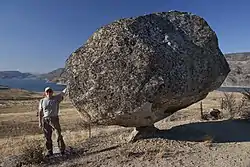Glacial erratic boulders of King County, Washington
Glacial erratic boulders of King County are large glacial erratic boulders of rock which were moved into King County, Washington by glacial action during previous ice ages.
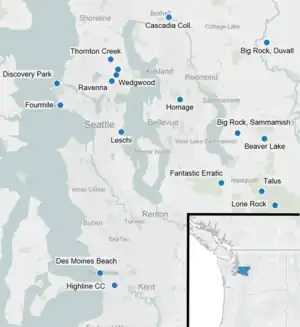
The Pleistocene ice age glaciation of Puget Sound created many of the geographical features of the region, including Puget Sound itself,[1] and the erratics are one of the remnants of that age.[2] According to Nick Zentner of Central Washington University Department of Geological Sciences, "Canadian rocks [are] strewn all over the Puget lowland, stretching from the Olympic Peninsula clear over to the Cascade Range."[3] Erratics can be found at altitudes up to about 1,300–1,600 feet (400–490 m) in the Enumclaw area,[4] along with kames, drumlins,[5] and perhaps also the unique Mima mounds.[6] The soil of Seattle, the county's (and state's) largest city, is approximately 80% glacial drift, most of which is Vashon glacial deposits (till),[7] and nearly all of the city's major named hills are characterized as drumlins (Beacon Hill, First Hill, Capitol Hill, Queen Anne Hill) or drift uplands (Magnolia, West Seattle).[3][8] Boulders greater than 3 meters in diameter are "rare" in the Vashon till,[2] but can be found, as seen in the table below.
List of boulders
| Name and description | Height | Image |
|---|---|---|
| Beaver Lake Preserve erratics are glacial erratics in and around protected space in Sammamish, weighing up to 100 tons.[9] The lake is a kettle lake also due to glaciation.[9] In the 1950s otters would reportedly rest on the large erratic at the north end of Beaver Lake.[10] | ||
| Big Rock is an 8-foot (2.4 m) tall glacial erratic in the city of Duvall. A Duvall road, a park, and several businesses are named after it.[11][12] The rock, and two non-native sequoias adjacent to it probably planted by area pioneers, are a local landmark.[13] The erratic lies in what is said to be the smallest King County park, 20 by 70 feet (6.1 m × 21.3 m) in extent, that barely contains the rock and sequoias.[14] The two lanes of Big Rock Road used to split into a wye around the rock, until a shopping center was built nearby in the 1990s.[14][13] | 8 feet (2.4 m) | 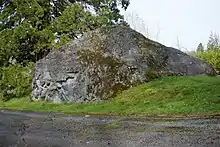 |
| Big Rock Park erratic is a glacial erratic in the eponymous city park in Sammamish. Sammamish considered naming the park "Bigger Rock Park" to distinguish it from the identically named park in Duvall.[15] | 8 feet (2.4 m) | 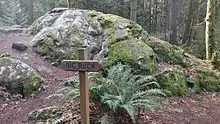 |
| Cascadia College erratic
Saved from destruction by sit-in conducted by Cascadia College environmental politics students, and relocated away from construction site.[16][17][18][19][20] The rock, which several students occupied during the sit-in, was about 2 meters across before being jackhammered to two thirds its original size.[19] |
3 feet (0.91 m) | 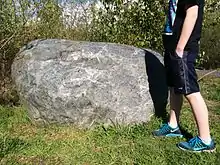 |
| Des Moines Beach erratic near Des Moines Beach Park in Des Moines
8 by 6 by 4.5 feet (2.4 m × 1.8 m × 1.4 m)[21] |
4.5 feet (1.4 m) | 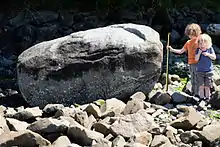 |
| Discovery Park beach erratics
Four or more erratics on beach below Discovery Park. Largest is 15.33 feet (4.67 m) high, 69.5 feet (21.2 m) in circumference.[22] |
15.33 feet (4.67 m) | 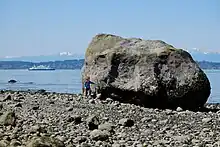 |
| Fantastic Erratic is a glacial erratic in Cougar Mountain Regional Wildland Park near Bellevue. It is approximately the size of a two-car garage, and 15 feet (4.6 m) high.[23][24] | 15 feet (4.6 m) | 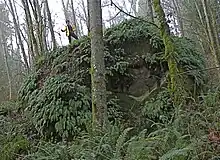 |
| Four Mile Rock (also Fourmile Rock) is a round granite erratic, approximately 20 feet (6.1 m) across, in the intertidal zone below Seattle's Magnolia Bluff and 60 yards offshore.[25] It has had a navigational light placed on it and appears on nautical charts.[26]
Native Americans called the rock LE'plEpL, also written La'pub, and also called it Tele'tla (meaning "rock"). A legend says that a hero named Sta'kub could throw a giant cedar and hazel branch dragnet over the rock while standing at the beach.[27] |
15 feet (4.6 m) | 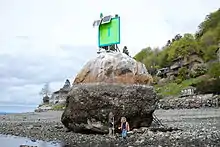 |
| Unnamed erratic at Highline College. Granitic with "textbook en echelon dikes". 21 by 12 feet (6.4 m × 3.7 m) and 9 feet (2.7 m) high.[29] | 9 feet (2.7 m) | 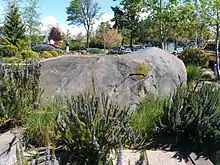 |
| Homage artwork boulders, three locations in Bridle Trails neighborhood of Bellevue,[30] using "local granite boulders".[31] Exposed granitic bedrock does not occur in western King County.[32]
47°37′57.8″N 122°10′46.3″W (NE 24th)
|
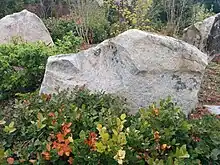 | |
| Leschi Park erratic in Seattle's Leschi Park is a sandstone erratic with many embedded bivalve fossils. Analysis of the fossils and the rock's minerals shows it may have come from the Nooksack Group near Mount Baker, or from the Harrison Lake area of southern British Columbia.[33] | 5 feet (1.5 m) | 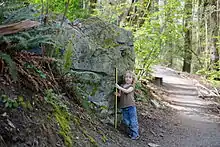 |
| Lone Rock in Tiger Mountain State Forest on Tiger Mountain[34][35] | c. 15 feet (4.6 m) | 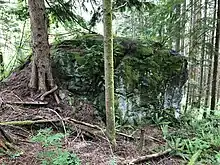 |
| Ravenna Park erratic in Ravenna Park in Seattle, a granodiorite stone three yards (2.75 meters) tall in Ravenna Creek with a wooden footbridge that wraps around it.[36][37] | c. 10 feet (3.0 m) | 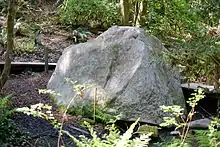
|
| Talus Rocks, a collection of piled erratics in Tiger Mountain State Forest on Tiger Mountain,[38][39][40] forming rock caves (called "Devil's Dens" in New England[41]) said to be among the largest in Washington.[42] | c. 12 feet (3.7 m) | 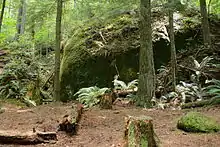 |
| Thornton Creek erratic near 17th Ave. NE and NE 104th St., in Seattle Parks' Kingfisher Natural Area. A local conservation group calls the area containing the boulder "Erratic Flats".[43] | c. 8 feet (2.4 m) | 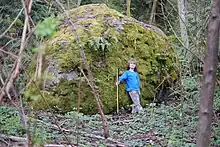 |
| Wedgwood Rock is a glacial erratic (and known to geologists as the "Wedgwood Erratic") near the neighborhood of Wedgwood in Seattle, Washington. It is 80 feet (24 m) in circumference and 19 feet (5.8 m) or 26 feet (8 m)[44] in height. Since 1970 it has been an offense punishable by a $100 fine to climb the rock.[45] | 26 feet (8 m) | 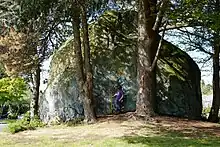 |
| Anonymous erratic in Wedgwood Square Park[46] | c. 4 feet (1.2 m) | 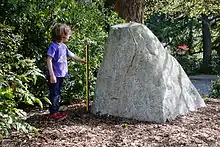 |
References
- Notes
- Troost & Booth 2008, p. 12 "During the period that the Vashon-age ice sheet covered the region, a tremendous volume of pressurized water was carried by subglacial streams and was responsible for carving the deep troughs of the modern Puget Sound."
- Booth, Troost & Shimel 2008.
- Geology of Seattle and the Puget Sound on YouTube, narrated by Nick Zentner (Central Washington University Department of Geological Sciences). Uploaded March 2, 2015 by Hugefloods.com (Nick Zentner and Tom Foster: Discover the Ice Age Floods).
- Bretz 1913, p. 34.
- Goldstein 1994.
- Pailthorp, Bellamy, "Mima Mounds continue to mystify scientists", KPLU Wonders, KPLU
- Troost & Booth 2008, p. 2.
- Troost & Booth 2008, p. 5.
- D. Bruce Morgan, Beaver Lake Geology, Sammamish, Washington: Beaver Lake Community Club
- Morgan 2012, p. 1.
- Dave Tucker (April 12, 2011), Dave Tucker (ed.), "'Big Rock' (another one) in Duvall, Washington", Northwest Geology Field Trips
- Duvall Visitors Guide (PDF), Duvall Chamber of Commerce, 2015
- Louis T. Corsaletti (March 10, 1998), "Big Rock, Big Trees, Little Park -- New Safeway Being Built Near Tiny Duvall Landmark", The Seattle Times
- "Washington Rock is County Park", Reading Eagle, Reading, Pennsylvania, p. 42, May 15, 1977
- "Lame names | Sammamish can't find permanent title for SE 8th Street Park". 28 February 2013.
- "Cascadia Community College students move into action to save a piece of geologic history", Bothell/Kenmore Reporter, February 22, 2010
- "Cascadia students save Ice Age boulder, get it moved from construction site | Bothell | Seattle News, Weather, Sports, Breaking News | KOMO News". Archived from the original on 2015-04-17. Retrieved 2015-04-08.
- Students Sit In to Save Boulder at Cascadia (Press release), Cascadia Community College, February 12, 2010, archived from the original on 2010-05-27
- Kristi O'Harran (February 23, 2010), "Cascadia College rock-solid about its boulder", Everett Herald
- Micah Silke (September 26, 2012), "Construction: UWB 3 and the Sports and Recreation Complex", Husky Herald, University of Washington at Bothell, archived from the original on September 24, 2015
- Bud Hardwick (c. 2011), Dave Tucker (ed.), "Des Moines Beach erratic", Northwest Geology Field Trips
- "Beach Erratics at Discovery Park, Seattle". 27 January 2012.
- Greg Kulseth (June 30, 2011), Dave Tucker (ed.), "Fantastic Erratic, Cougar Mountain Regional Park, King County", Northwest Geology Field Trips
- Stekel 2009, p. 152.
- Ray 1891, p. 37.
- Puget Sound – Shilshole Bay to Commencement Bay (PDF) (Natucial chart), National Oceanic and Atmospheric Administration National Ocean Service, Office of Coast Survey, 2015, NOAA Chart 18474, archived from the original (PDF) on 2015-04-27, retrieved 2015-04-03
- Waterman 1922, p. 188.
- U.S. Geological Survey Geographic Names Information System: Fourmile Rock
- Magmatist (February 21, 2012), Dave Tucker (ed.), "Thin en echelon dikes in the Highline Community College erratic", Northwest Geology Field Trips
- Bridle Trails art, City of Bellevue Department of Planning & Community Development, 2014
- Bruce Myers, Bridle Trials Artist's Statement (Homage) (PDF), City of Bellevue Arts Program
- Livingston 1971, p. 31 Figure 12, "Relation of metallic ore deposits to granitic rocks in King County, Washington"
- Dave Tucker; Doug McKeever; Wes Gannaway (2011), Dave Tucker (ed.), "The fossil-rich erratic at Leschi Park", Northwest Geology Field Trips
- Alan Gibbs, Tiger Mountain Trail north, Washington Trails Association
- Jon F. Stanley (November 1, 2008), Tiger Mountain State Forest trail map (PDF), switchbacks.com
- Hutton 2012.
- Dave Tucker (May 6, 2011), Dave Tucker (ed.), "Ravenna Park granodiorite erratic, Seattle", Northwest Geology Field Trips
- Weber & Stevens 2010, p. 101.
- Dolan 2004, p. 167.
- Talus Rock trail, Washington Trails Association, retrieved 2015-04-20
- Daniel V. Boudillion (2009), "Picture Glossary of New England Lithic Constructions", New England megaliths field journal
- West Tiger Mountain NRCA, Washington State Department of Natural Resources, archived from the original on 2013-04-17, retrieved 2015-04-20
- Kingfisher Forest Stewards (November 2, 2014), Kingfisher Natural Area events, Green Seattle Partnerships
- Troost & Booth 2008.
- David Wilma (July 24, 2001), "Seattle Neighborhoods: Wedgwood -- Thumbnail History", HistoryLink, Seattle: History Ink
- http://wedgwoodinseattlehistory.com/2012/03/15/parks-in-wedgwood/
- Sources
- Booth, Derek B.; Troost, Kathy Goetz; Shimel, Scott A. (2008), Geologic Map of Northeastern Seattle (Part of the Seattle North 7.5 X 15-minute Quadrangle), King County, Washington: Geologic Summary, United States Geological Survey
- Bretz, J Harlen (1913), Glaciation of the Puget Sound Region (PDF), Washington Geological Survey.
- Dolan, Maria (2004), "Tiger Mountain: Talus Rocks", Outside Magazine's Urban Adventure: Seattle, W. W. Norton & Company, ISBN 9780393323979
- Goldstein, Barry (1994), "Drumlins of the Puget Lowland, Washington State, USA", Sedimentary Geology, 91 (91): 299–311, Bibcode:1994SedG...91..299G, doi:10.1016/0037-0738(94)90136-8
- Hutton, Jane (December 2012), "Distributed Evidence: Mapping Named Erratics", in Ellsworth, Elizabeth; Kruse, Jamie (eds.), Making the Geologic Now;Responses to Material Conditions of Contemporary Life, pp. 99–103, ISBN 978-0-9882340-2-4
- Livingston, Vaughn E. (1971), Geology and Mineral Resources of King County, Washington (PDF), State of Washington Department of Natural Resources in cooperation with United States Geological Survey, Bulletin 63
- Morgan, Bruce (June 2012), "Part 6 of the Series: Living with Your Next Door Wildlife Neighbors: Memories of Beaver Lake Wildlife" (PDF), The Beaver Lake Monitor, Sammamish, Washington: Beaver Lake Management District Advisory Board, vol. 13, no. 1, archived from the original (PDF) on 2015-09-24
- Ray, Robert C., ed. (1891), The Coast of British Columbia: Including the Juan de Fuca Strait, Puget Sound, Vancouver and Queen Charlotte Islands, U.S. Government Printing Office, Issue 96 of US Navy Bureau of Navigation, Hydrographic Office; Volume 15106 of CIHM/ICMH Microfiche series
- Stekel, Peter (2009), "Chapter 18: Cougar Mountain", Best Hikes Near Seattle, Rowman & Littlefield, p. 152, ISBN 9780762755813
- Troost, Kathy Goetz; Booth, Derek B. (2008), Geography of Seattle and the Seattle area, Washington, Geological Society of America, doi:10.1130/2008.4020(01)
- Waterman, T.T. (1922), "The Geographical Names Used by the Indians of the Pacific Coast—Indian Place Names About Seattle", Geographical Review, American Geographical Society, 12, doi:10.2307/208735, JSTOR 208735
- Weber, Andrew; Stevens, Bryce (2010), 60 Hikes Within 60 Miles: Seattle: Including Bellevue, Everett, and Tacoma, Menasha Ridge Press, ISBN 9780897328128
Further reading
- John Figge (2008), The Glacial Origins of the Puget Basin: The Evolution of the Modern Lowland Landscape (PDF), The Northwest Geological Institute – via North Seattle Community College
- Hannah Holmes (March 2012), "Rock ... And Roll: How a glacier pushed a boulder to a place near you", National Geographic
External links
- Washington glacial erratics project at University of Washington dept. of earth and space sciences
